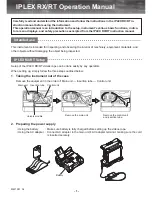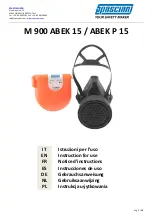
GN128-Explosion-Proof Piston Rev. 0
Orange Research Inc.
Page 1 of 2
INSTRUCTIONS
Series 1204
DIFFERENTIAL PRESSURE INSTRUMENTS
Piston Sensor
– Explosion Proof
Your new Orange Research Differential Pressure Instrument is a
rugged instrument featuring simplicity of design to provide
dependable and efficient service. Because it is an instrument it
should be handled with care. Read all instructions carefully
before attempting to install the instrument.
CAUTION
: Do not exceed maximum operating pressure
listed on instrument label. Use only fluids compatible with
wetted parts, including seals.
HOW IT WORKS
The instrument operates on the difference between two
pressures (delta-P). The sensing element is a spring biased
piston which moves linearly in proportion to the difference
between two basic pressures. A magnet on the
HI
pressure side
of the piston assembly moves with the piston and rotates a
follower magnet located adjacent to the pressure cavity. The
gauge pointer is located at the end of the rotary magnet shaft and
rotates with the magnet to provide gauge readings proportional to
differential pressure variations. This is accomplished by the
coupling forces between two adjacent magnets through a solid
wall.
SWITCHES:
A secondary magnet, located in the extension tube
also moves with the pressure sensor. Reed switches, mounted
externally on the pressure extension tube are actuated when the
field of the secondary magnet interacts at a preset point with the
reed switch armatures.
NOTE:
This instrument will provide
2% accuracy full scale.
INSTALLATION
Check instrument and identify the
HI
and
LO
markings.
HI
identifies the high pressure port;
LO
the low pressure port. If
instrument is installed backwards, it will neither operate nor be
damaged. The instrument can be line mounted, pipe mounted or
panel mounted.
Installation Notes:
These piston sensor instruments are design for liquid
service only…use in gas systems will result in erroneous
readings due to excessive piston bypass
Do not mount directly to steel surfaces…this could affect
the magnetic sensors…mounting 1 inch from ferrous
metals is recommended
If there is particulate in the line, insert a screen (approx.
100 micron) to block the particulate from becoming
lodged in the instrument
Do not install on systems for highly viscous fluids or
where the fluid may become hardened over time
Do not install on systems with iron in the fluid…the iron
can become attached to the magnetic sensors
Install the unit above the process lines to prevent
particulate from settling in the instrument
Before installation, refer to our Specification Sheets (on
our website) to identify instrument component materials
& double check for chemical compatibility
MAINTENANCE
Other than replacing a broken lens, there is only one area where
this instrument may need attention. Erratic pointer or switch
action may indicate that cleaning is required. For cleaning:
1. Remove the unit from service.
2.
Remove end cap with a 1” spanner wrench.
3. Remove the range spring and the piston/magnet assembly.
BE CAREFUL NOT TO LOSE STACKING SPACERS, IF
ANY.
4. Clean parts
in a solvent solution after removing the “O”-ring
seals from the end caps since some solvent will attack the
seal material.
5.
It is good practice to replace the “O”-ring seals while the
instrument is dismantled. DO NOT ATTEMPT TO REMOVE
THE TEFLON PISTON SEAL FROM THE PISTON. If piston
seal is damaged order a new piston/magnet assembly.
To reassemble:
1. Replace the piston assembly.
CAUTION:
Do not bend the
stainless steel wire which connects the secondary magnet to
the piston assembly.
2. Make certain that the spacers are seated in the piston spring
pocket and reinsert the spring.
3. Reassemble the end cap and tighten.
NOTE:
Be certain that
the head of the spring is seated in the end cap spring
pocket. The unit is now ready for service.
LENS REPLACEMENT:
To remove a threaded retaining ring,
unscrew the retaining ring, or to remove the snap ring, pry out the
ring with a small screwdriver. Remove the glass chips, insert
new lens and reinstall the snap ring and threaded ring. For snap
rings locate the ring joint at the bottom of the gauge.
POINTER REPLACEMENT:
(probably damaged when lens was
broken). Remove Threaded ring or snap ring as previously
described and clean out glass chips. Remove old pointer with
pointer puller or two small screwdrivers opposite each other
under pointer hub. Pry off evenly being careful not to bend the
pointer shaft. Install new pointer dead on zero. Re-install lens, as
described under Lens Replacement.




















